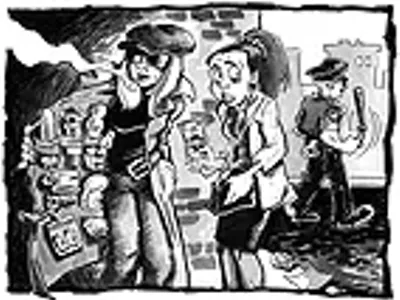We all know darn well that the average American doesn’t mind a few minutes of fame by being on TV. But getting caught unawares without the chance to powder ’n’ perform like the real celebs – well, that sort of takes all the fun out of it.
Think of one of those drunk baby sitter sting operations. Or just ask "60 Minutes II" about the trouble with televising "reality." Hours before an exposé on a chain of psychiatric hospitals was to air last week, CBS lawyers were in court fighting an order to suppress the program. The chain, Charter Behavioral Health Systems, lost its case, and the report aired.
A social worker with a camera hidden in the bridge of his eyeglasses had gone undercover for CBS at a Charter facility in North Carolina. And the videotape he brought back was beyond disturbing. The distorted screams, the blurred bodies of patients being dragged by the limbs, writhing with fear and pain, stumbling in overmedicated hazes and being strapped down on beds by untrained staff made the thought of speak no evil, see no evil, hear no evil seem like a pretty good idea. But despite popular myth, that was real TV.
And what a far cry it is from the Jerry-Springer-with-a-bailiff studio circuses called TV court, a subset of stuff called "reality programming."
When Judge Joseph A. Wapner first called the nationally syndicated "People’s Court" to order in 1981, who would’ve thought the late ’90s would find network TV cluttered with black-robed talk show hosts trying to exude a sense of dignity with a gavel, some wood paneling and an American flag hanging limply in the background? Let’s not fool ourselves into thinking that viewers are tuning into Judge Judith Sheindlin, Judge Joe Brown, Judge Mills Lane and the new "People’s Court" emcee, Judge – and former New York City Mayor – Ed Koch, because of a hunger for justice. Or how about a need to keep up with changes in America’s legal system? Nice try.
Despite the fact that she’s only been on TV for a few years, Judge Judy may be the most popular and is surely the most parodied on-screen honorable of them all. "Saturday Night Live"’s Cheri Oteri has done a hilarious job of capturing the ridiculousness of a lace-collared legal matriarch handing out more consternation and quirky one-liners than verdicts: "Sir, don’t pee on my leg and tell me that it’s raining."
He may not grab as much attention as the neatly coiffed Judge J., but Lane, a 60-year-old former boxing referee, famous for disqualifying Mike Tyson after he bit Evander Holyfield in 1997, has gone all out for TV appeal. The show’s intro builds up the judge with boyhood-in-the-country nostalgia and the fact that he served in the Marine Corps. Add his catchphrase, "Let’s get it on!" and you have a winner for sure, or at least an adequate ringleader, whose all-American, God-fearing sense of decency and lightweight Southern drawl just might save the day. Or maybe not.
Let’s not kid ourselves – again – by imagining that these personalities alone are keeping the late-afternoon small claims dramas afloat. The same way viewers tolerate the red-bespectacled wonder, Sally Jesse Raphael, to find out if a cheating husband passed the lie detector test – of course he didn’t – TV court viewers are tuning in to get the dirt on the other average guy.
TV court is a voyeuristic feast, a dim kaleidoscope of jilted lovers, engagement rings in hock, feuds between landlords and tenants, missing-in-action caterers, stolen bicycles, family fights and, generally speaking, ordinary folks who can’t get their shit together. Often, plaintiff and defendant are unprepared, meandering into irrelevant but juicy testimony, and slinging insults back and forth while the judges are lucky to get a word in edgewise.
These King Solomons who admonish, order restitution and show the lost souls who wander onto their sets the brightly paved path to morality and good citizenship are really just there to help flesh out the gory details and, of course, the laughs, hoots and hollers of an audience. While the jeers and cheers are tame compared to those heard on Springer or Ricki Lake, the "Go Judy! Go Judy! Go Judy!" cadence is easily detected, even under the guise of order in the court.
When the hearings are over, some perky staff reporter follows the litigants out into the lobby to get a final word on how they feel about the outcome of their case. Yep, they still don’t know what they’re talking about.
Like the hype says, the cases are real and the decisions final, but isn’t winning a case on one of these shows just a consolation prize for looking like a fool? Walking out of there a few bucks richer but looking really stupid is the same as having Montel or Geraldo promise to pay for your therapy after admitting that you’re an obsessive-compulsive, bisexual, philandering smack addict on national television.
Of course, if you subscribe to Court TV on cable, you could have tuned in to a real courtroom drama recently. The live broadcast of the Jenny Jones trial from Pontiac took up most of the daytime slots from Monday to Friday. The animated lionheart, Geoffrey Fieger, must have thought he was still doing his radio show as he launched into wild diatribes, barely allowing Jones or other witnesses to spurt out a complete sentence during cross-examination. Now where’s Judge Judy when you really need her?





